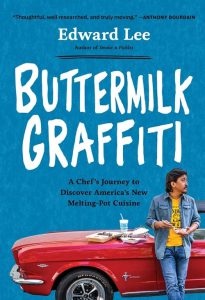What is American cuisine? Should we use the term “authentic” to describe a recipe or cuisine? These are just two of many questions that Edward Lee explores in his book Buttermilk Graffiti. Much like American cuisine, Buttermilk Graffiti is an amalgamation. Although the book is part memoir and part cookbook, it primarily focuses on the culinary traditions and stories of immigrants. At times it has the feel of a Bourdain-like food travel show, mixed with history and self-reflection. Lee explores the history of place, migration stories, and the personal histories of individuals whose culinary traditions started across the globe. As much as Lee attempts to better understand the vastness of American cuisine, he also explores his own place in American food culture, and shares fifty recipes inspired by the foods he encounters.
If you are unfamiliar with Edward Lee, he is a chef and restaurateur from Louisville, Kentucky. His culinary style has many influences, including his Brooklyn childhood, his Korean heritage, and the two decades he has lived in Kentucky. He entered the television realm by competing on Top Chef in 2011, and was featured on The Mind of a Chef in 2014. Lee published his first cookbook and memoir, Smoke and Pickles, in 2013. His Louisville restaurant 610 Magnolia boasts a modern approach to southern cooking.
Lee is a compelling storyteller and approaches people and their food cultures with curiosity and empathy. As part of this project he visited more than a dozen cities and explored many food traditions and cultures: Nigerian, Vietnamese, German, Scandinavian, Peruvian, Chifa, Cambodian, Uyghur, Arabic, a Kosher deli, and Louisville soul food. He often came away with more questions than answers and will leave you with many things to ponder:
- Does our education in global food depend on global tragedies that bring immigrants to this country?
- Is there some other way that we can honor the foods of other nations without the tragedy?
- When looking for the “authentic” food of a specific culture, are we looking for a nostalgia that doesn’t exist?
- Is cooking the food of others appropriation or learning?
“I wonder if in 100 years Americans will eat bibimbap without knowing where it came from. Isn’t that already happening to foods such as tacos and pizza? Or can we go back and recalibrate these beloved foods every time a new wave of immigrants comes to America?”
Lee reveals the complexity of food traditions and cultures and shows that there is no monolithic or “authentic” version of any particular food. Each chef’s personal story makes their recipe unique. At the same time, he shows connections between individuals and their traditions. The elder Scandinavians he meets in Seattle value the nostalgia of certain foods much like his own father, who was a Korean immigrant.
“You have your own story and your own history, and your own connections to make. There is good food to be discovered everywhere. All it takes are an adventurous palate and an inquisitive mind. You can link both to the foods that sit in your memories.”
At times Lee’s personal stories seem to fall into a familiar pop culture stereotype for chefs, focusing on what’s supposed to be edgy or rebellious. As Buttermilk Graffiti progresses, however, the reader gets a fuller picture of Lee’s life as a son, husband, and father, and what has shaped him as a chef. He shares vulnerable stories and does a lot of personal reflection, including sharing how he has pushed back against what a man of Korean ancestry in America is supposed to be.
Lee is a compelling writer who believes in the power of stories. If you are a fan of food writing and food culture, I think you will find many of these stories powerful and thought provoking as well.
Lee, Edward. Buttermilk Graffiti: A Chef’s Journey to Discover America’s New Melting-Pot Cuisine. Artisan, 2018.


